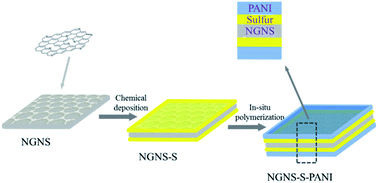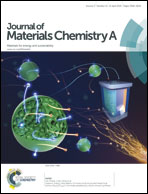Ternary-layered nitrogen-doped graphene/sulfur/ polyaniline nanoarchitecture for the high-performance of lithium–sulfur batteries
Abstract
Ternary-layered nitrogen-doped graphene/sulfur/polyaniline (NGNS-S-PANI) nanoarchitecture was rationally designed and synthesized via a two-step liquid chemical deposition approach. The SEM and TEM images indicate that the nanocomposite NGNS-S-PANI consists of N-doped graphene-sheets, sulfur and PANI with a layered structure. The ternary-layered NGNS-S-PANI exhibits excellent electrochemical performance compared with the corresponding binary-layered nitrogen-doped graphene/sulfur (NGNS-S). A highest specific discharge capacity up to 1277.3 mA h g−1 at the first cycle and 693 mA h g−1 over 100 cycles at 0.5 C were achieved with enhanced Coulombic efficiency of 98.5%, representing a promising cathode material for lithium–sulfur batteries. The high electrochemical performance of NGNS-S-PANI can be attributed to its well-designed ternary-layered nanoarchitecture. The rough surface of the ternary-layered composite with an elastic polyaniline (PANI) coating helps to retard the diffusion of polysulfides and to alleviate the volumetric expansion; also the nitrogen-doped graphene improved the electrical conductivity of the matrix.


 Please wait while we load your content...
Please wait while we load your content...